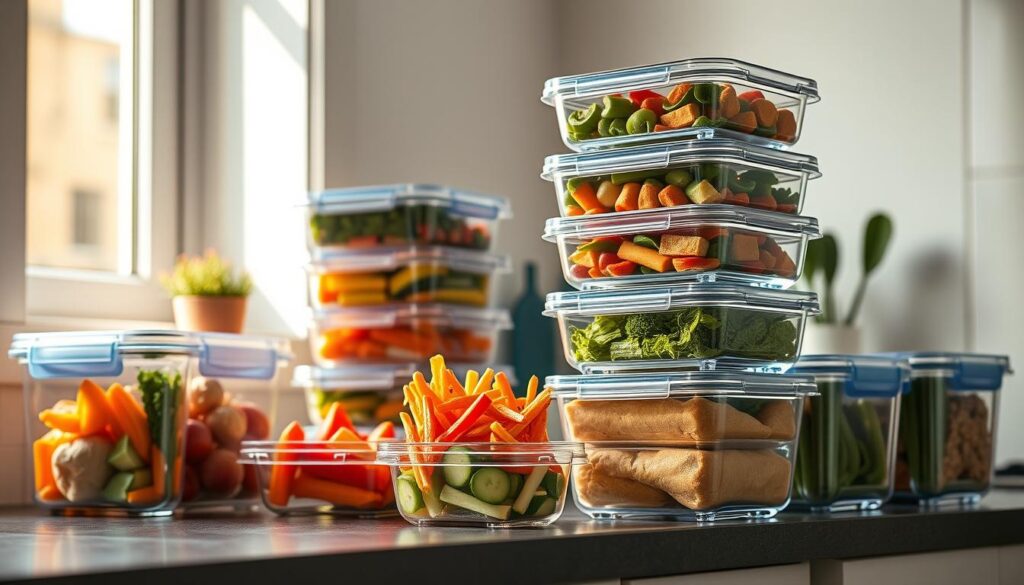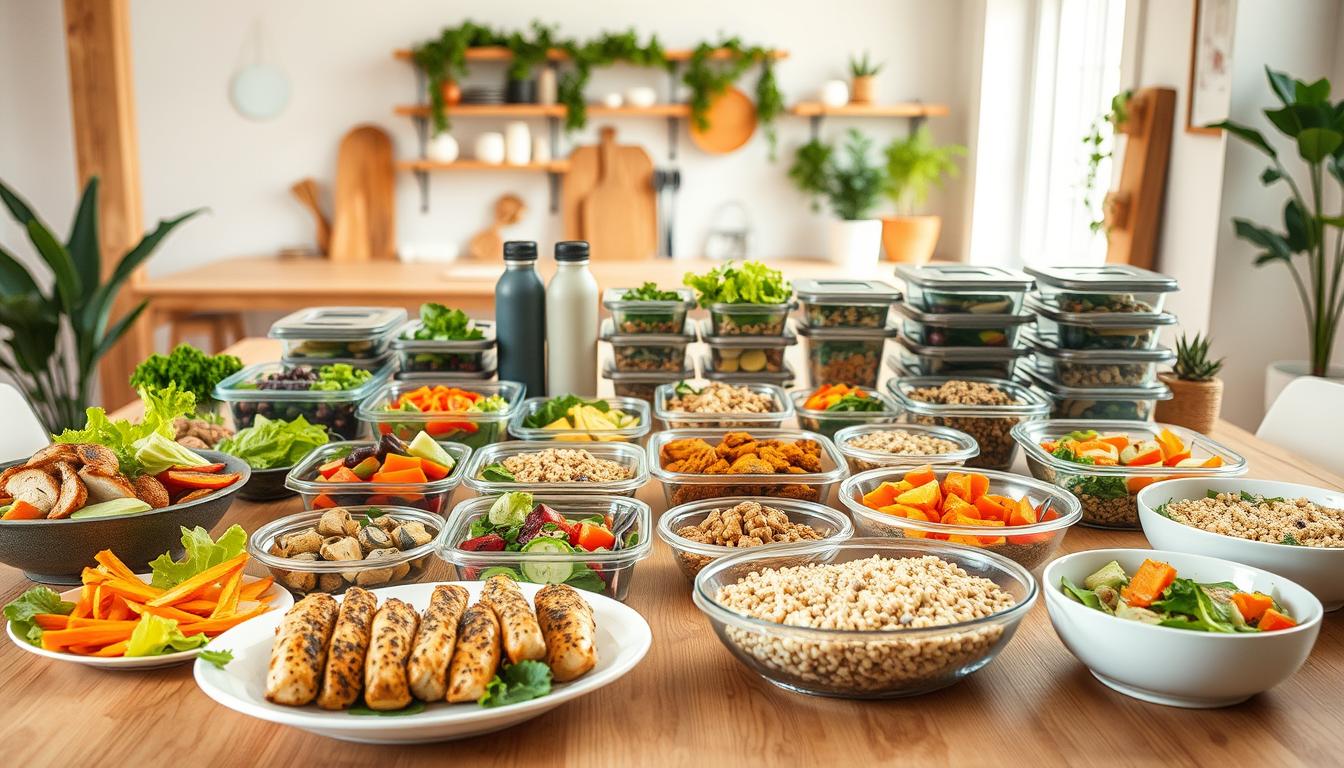Ideal Foods for Meal Prepping: Meal prepping saves time, money, and stress while eating healthy. Choosing the right ingredients is key to making the most of your meal prep efforts.
It’s important to pick healthy foods for meal prepping. This way, you can plan and prepare nutritious meals ahead of time. It ensures you’re giving your body the right fuel.
With a smart approach to meal prepping, you can enjoy healthy meals all week. This makes it easier to keep up with your health and fitness goals.
Contents
The Benefits of Meal Prepping
Meal prepping makes your life easier and healthier. It saves you time during the week. You can quickly grab a healthy meal without relying on takeouts or fast food.
It also encourages healthy eating by letting you plan meals ahead. This way, you avoid unhealthy choices and keep your diet balanced. Plus, it reduces food waste by planning your ingredients, making your kitchen more efficient.
What Foods Are Best for Meal Prepping?
Choosing the right foods for meal prep is crucial. Look for foods that are nutritious, versatile, and easy to make. They should also keep well when stored and reheated.
Great meal prep foods last longer and stay fresh in the fridge or freezer. They also retain their taste and texture when reheated. This makes them perfect for a balanced diet.
| Food Category | Examples | Storage Tips |
|---|---|---|
| Proteins | Chicken, Fish, Tofu | Refrigerate or freeze in airtight containers. |
| Vegetables | Broccoli, Carrots, Spinach | Store in the refrigerator, keep some in the freezer. |
| Grains | Rice, Quinoa, Whole Wheat | Keep in a cool, dry place or refrigerate. |
Focus on proteins, vegetables, and grains for your meal prep. Use meal prepping tips like cooking in bulk and storing properly. This way, you can make a healthy and lasting meal prep plan.
Protein Options for Successful Meal Prep
Good meal prep needs a variety of protein-rich foods. Protein helps repair muscles, keeps you full, and boosts health. It’s key to mix different protein sources for a balanced diet.
Tofu and Tempeh
Tofu and tempeh are great for those who don’t eat meat. Tofu comes from soybeans and can be marinated, baked, or stir-fried. It’s very flexible and takes on flavors well. Tempeh is fermented soy with a nutty taste and firm texture. Both are packed with protein and work well in many dishes, like stir-fries and salads.
| Protein Source | Nutritional Benefits | Culinary Uses |
|---|---|---|
| Tofu | High in protein, iron, and calcium | Stir-fries, salads, soups |
| Tempeh | Rich in protein, probiotics, and vitamins | Salads, sandwiches, grilled dishes |
| Beans | High in protein, fiber, and minerals | Soups, stews, salads, chili |
| Lentils | Rich in protein, fiber, and iron | Soups, stews, curries, salads |
Beans and Lentils
Beans and lentils are full of protein and fiber, making them very filling. They’re great for soups, stews, salads, and curries. Black beans, chickpeas, or lentils add nutrition and keep you full.
Adding tofu, tempeh, beans, and lentils to your meal prep boosts nutrition and variety. Mixing these options keeps your diet interesting and balanced.
Grains, Starches, and Vegetables That Hold Up Well
Choosing the right grains, starches, and vegetables is key for fresh meal prep. These foods are not only good for you but also versatile. They’re perfect for many meal prep ideas.
Grains like brown rice, quinoa, and whole wheat are top picks. They’re full of fiber, vitamins, and minerals. You can use them in salads, main dishes, and more. For example, quinoa is a complete protein that goes well with veggies and lean meats. Brown rice is great with Asian dishes.
Starches like sweet potatoes, yams, and regular potatoes are also good for meal prep. They’re filling and nutritious. You can bake, mash, or roast them. Sweet potatoes, for instance, are full of vitamin A and fiber.
Vegetables like broccoli, carrots, and bell peppers are also excellent choices. They keep their texture and taste even after refrigeration. Broccoli is rich in vitamins C and K. It’s a great side dish when steamed. Carrots and bell peppers are good in salads or with hummus.
Mixing these grains, starches, and vegetables with proteins like chicken, beans, or tofu makes for balanced meals. For example, a bowl with quinoa, roasted sweet potatoes, steamed broccoli, and grilled chicken is both healthy and tasty.
By adding these ingredients to your meal prep, you’ll have many healthy and tasty meals ready. This makes eating well easier than ever. [Ideal Foods for Meal Prepping]
Flavor Boosters and Seasonings
Take your meal prep to the next level with herbs and spices. They add flavor without salt or sugar. The right boosters can change how much you enjoy your meals.
Herbs like basil, oregano, and thyme add depth to your food. You can use them fresh or dried, depending on your recipe. Spices like cumin, paprika, and turmeric not only taste great but are also good for you.
Try new seasonings and flavor boosters to find your new favorite recipes. For example, a simple salad can become amazing with homemade vinaigrette or toasted seeds.
Change up your flavor boosters and seasonings to keep things interesting. This makes your meals taste better and ensures you get a variety of nutrients. [Ideal Foods for Meal Prepping]
Storage Techniques and Food Safety
To keep your meal prep fresh and safe, knowing how to store it is important. Storing food right helps keep your meals good and stops food sickness. [Ideal Foods for Meal Prepping]
Use airtight containers to keep moisture and harmful stuff out. For quick storage, the fridge is best. Make sure your fridge is at 40°F (4°C) or lower to keep food safe.

For longer storage, freezing is a good choice. Freezing stops bacteria from growing, keeping your food safe longer. When you’re ready to eat, heat your meal to 165°F (74°C) to ensure it’s safe.
| Storage Method | Temperature | Reheating Temperature |
|---|---|---|
| Refrigeration | 40°F (4°C) or below | N/A |
| Freezing | 0°F (-18°C) or below | 165°F (74°C) |
Always check your food for signs of spoilage before consuming it, even if it’s been stored properly. By following these storage techniques and guidelines, you can enjoy your meal prep while keeping food safety in mind.
See Also: Healthy Family Meals for Weight Loss
Conclusion: Ideal Foods for Meal Prepping
You now know how to succeed with meal prep. By picking the right foods, you save time, eat well, and cut down on waste. Make sure to include protein, whole grains, and lots of veggies in your prep.
When you start, try new flavors and spices to keep your meals interesting. Also, learn how to store your food right to keep it fresh and safe. [Ideal Foods for Meal Prepping]
With these tips, you’re set to improve your nutrition through meal prep. Begin with a simple plan and tweak it as you go. This way, you’ll enjoy a successful meal prep journey.
FAQ
What are the best foods to meal prep?
The top picks for meal prep are foods that are healthy, can be stored well, and taste great when warmed up. Think brown rice, quinoa, sweet potatoes, broccoli, tofu, tempeh, beans, and lentils.
How do I keep my meal prep interesting?
To make meal prep fun, try new herbs, spices, and seasonings. Also, mix up your protein and veggies to keep things exciting. [Ideal Foods for Meal Prepping]
How long can I store meal prep in the fridge?
You can keep meal prep in the fridge for three to five days. Always check for any signs of spoilage before eating. [Ideal Foods for Meal Prepping]
Can I freeze my meal prep?
Yes, many meal prep items can be frozen. This includes cooked grains, veggies, and proteins. Just use airtight containers or bags to avoid freezer burn.
How do I reheat meal prep safely?
To safely reheat meal prep, heat it to 165°F (74°C). You can use the microwave, oven, or stovetop, depending on what you’re reheating. [Ideal Foods for Meal Prepping]

Hi, I’m Waverly Moon, creator of TipsToFeelBetter.com. This blog is for practical moms and family-focused women seeking simple, realistic ways to improve daily life. From home routines to self-care, I share tips that truly work—because life doesn’t need to be perfect to feel better. Let’s make everyday moments a little easier, together.

